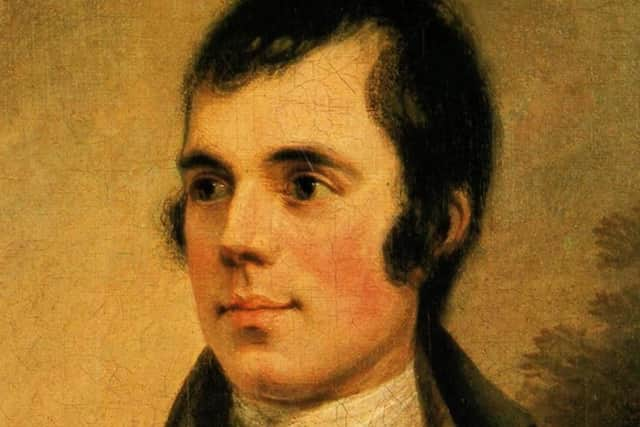Burns Night: Seven fascinating facts about Robert Burns


Over the course of over a couple of centuries the commemoration of his birthday (January 25, 1759) has developed into a formal occasion full of arcane and deeply traditional whimsy (eg “the toast to the lassies”).
It’s laced with the sort of humour which worked well in the early 19th century, and is intensely “blokeish” – some would say outright sexist – and much fuss is made about the haggis, and of course whisky.


Advertisement
Hide AdAdvertisement
Hide AdBut if you thought you knew everything you wanted to know about this most famous of Scots, here are seven Interesting Facts about his legacy you may not have encountered before.
1. Asked what had been the source of his greatest inspiration, corncrake-voiced warbler Bob Dylan said it was Burns’ 1794 song “Red, Red Rose”.
2. Astronaut Nick Patrick carried a volume of Burns’ poetry with him on a 2010 space mission which saw him travel 5.7 million miles while orbiting the Earth 217 times. It’s not explained why.
3. The oldest existing statue of Burns is thought to be in Camperdown, Australia. Carved by one John Greenshields, it was shipped there during the 1850’s.


Advertisement
Hide AdAdvertisement
Hide Ad4. The late Michael Jackson had reportedly worked on an album in which some of Burns’ poems were to be set to music.
5. John Steinbeck’s 1937 novel “Of Mice and Men” takes its title from a famous line in Burns’ “To a Mouse”: “The best laid schemes o’ mice and men gang oft agley”.
6. Mosgiel, a town near Dunedin, New Zealand, is named after Burns’ farm in Ayrshire.
7. The former Soviet Union was the first country in the world to honour Burns with a commemorative stamp marking the 160th anniversary of his death in 1956.
The first Burns Supper, and more Rabbie Burns facts:
Advertisement
Hide AdAdvertisement
Hide AdMeanwhile, the first ever Burns Supper was staged at Burns Cottage by his friends on July 21, 1801, the fifth anniversary of his death.
The first still-existing Burns Club is said to have been founded in the same year by Ayrshire-born merchants, some of whom had known Burns.
They set the pace for the January Burns Supper by staging a memorable shindig on January 29, 1802, on what they thought was his birthday – but got the date wrong.
Ayr parish records showed his birthday had actually been January 25 - and they have been held on or around that date ever since.
Advertisement
Hide AdAdvertisement
Hide AdAmong questions continually asked about Burns are the classic: “Did Burns wear a kilt”?
Some answer this with a flat “no”, as tartan had been outlawed after the Jacobite Rising of 1745 (along with bagpipes – although in their case the Rising may just have been a flimsy excuse).
However they’re wrong, because it had never been made illegal in the Lowlands (which had largely stayed staunchly loyal to Mad King George).
There are plenty of references to people – usually the humblest of folk – wearing a simple form of tartan in places like Falkirk and Kilmarnock, and it was manufactured in many Lowland towns too.
Advertisement
Hide AdAdvertisement
Hide AdAlso by the time Burns was in his very short-lived prime several already-famous regiments in Highland dress had become the shock troops of the British army, although they wore “Government sett”, a dark green army tartan.
Despite all this the answer is probably still no – Burns was a Lowland farmer trying to make it as a high society literary figure among Edinburgh toffs, and would have been conventionally dressed, in breeches (Kilmarnock bonnet optional).
What about whisky and haggis?
Burns considered himself a connoisseur of whisky, wrote frequently about particular blends, and not only drank uisge beatha but put it centre stage in several of his most famous poems.
On the other hand he also suffered desperate hangovers and once wrote remorsefully along the lines of “never again”.
Advertisement
Hide AdAdvertisement
Hide AdHe may also have consumed cognac, which was the drink of choice of the polite society he aspired to impress.
While smuggling was precarious and difficult in places like Cornwall (think “Poldark”) the Scottish seaboard was virtually defenceless against illegal spirits imports, and “everyone was at it”.
Between illegal whisky from the Highlands and contraband cognac from France Scotland was awash with strong booze, and mass-drunkenness was common – an epidemic, according to the Church of Scotland.
Burns, an exciseman himself, exemplified the impotence of HM Customs in Scotland in “the de’il’s awa’ wi’ the exciseman”.
Advertisement
Hide AdAdvertisement
Hide AdHaggis, a form of blood sausage - common in many variants across Europe - was a peasant dish concocted from offal.
Burns’ praise for the haggis is a tribute to the virtue of thrift, ingenuity and the ability of ordinary people (often on the verge of starvation) to make a nutritious meal based on meat product leftovers – it’s unlikely he’d ever have swapped a good steak for a dish of haggis.
Raising it to the status of delicacy and “great chieftain o’ the pudden race” was about human resourcefulness, not gourmet cuisine.
He’d possibly have been highly amused to discover it was the focal point of an annual dinner given – worldwide – in his honour.
Advertisement
Hide AdAdvertisement
Hide AdBut it is unquestionably Scotland’s national dish, a continual source of puzzlement and even fear among baffled foreigners.
these days haggis from family butchers has been joined by the vast range from major brand name McSween, with others in the premier haggis league such as Simon Howie also vying for attention in supermarkets.
Since Indian food is still the nation’s favourite, surpassing even Italian, it’s maybe no surprise to find that haggis pakora is also a popular option in shops - adding an international note of which the Bard would surely have approved.
For more on Burns and Burns Suppers visit www.scotland.org/whats-on/burns-night